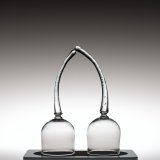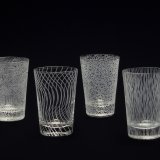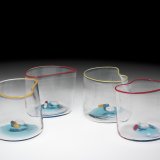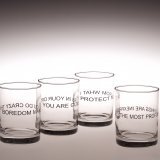A collection of objects selected by Tina Oldknow, curator of modern glass, presents glass design from the Museum’s permanent collection in association with the 2012 exhibition, Making Ideas: Experiments in Design at GlassLab. Not all of the objects in this collection may be currently on view at the Museum.
Contemporary Design
Drinking glasses on view include the work of emerging and established designers, as well as artists coming to design from other disciplines, such as Sara Musselman, Studio Polka (Marie Rahm and Monica Singer), Maria Grazia Rosin, Sol LeWitt, Jenny Holzer, Philippe Starck, and Bennett Bean. These glasses reflect recent trends in contemporary design, such as the interest in the field shown by painters and sculptors, and the increasing use of production processes that extend beyond the machine to the handmade.
Table wares by Tord Boontje, Emma Woffenden, and Hella Jongerius reflect other trends in contemporary design, such as the interest in sustainable, environmentally responsible products that support local communities. Objects by designers Ettore Sottsass and Gaetano Pesce, and artist Katherine Gray, explore the shifting boundaries between design, craft, and art.
Steuben Glass, which was founded in Corning, New York, in 1903, closed its doors in 2011. Steuben’s products are characterized by their high-quality material, expert craftsmanship, and distinctive designs. In 1939, the company commissioned designs for engraved decoration from painters and sculptors for its “Twenty-Seven Contemporary Artists” series, which enhanced its luxury product line. This practice continued, in the 2000s, with the invitation of well-known artists and designers, such as Kiki Smith and Ted Muehling, and emerging artists, such as Beth Lipman, to create products for Steuben.
















